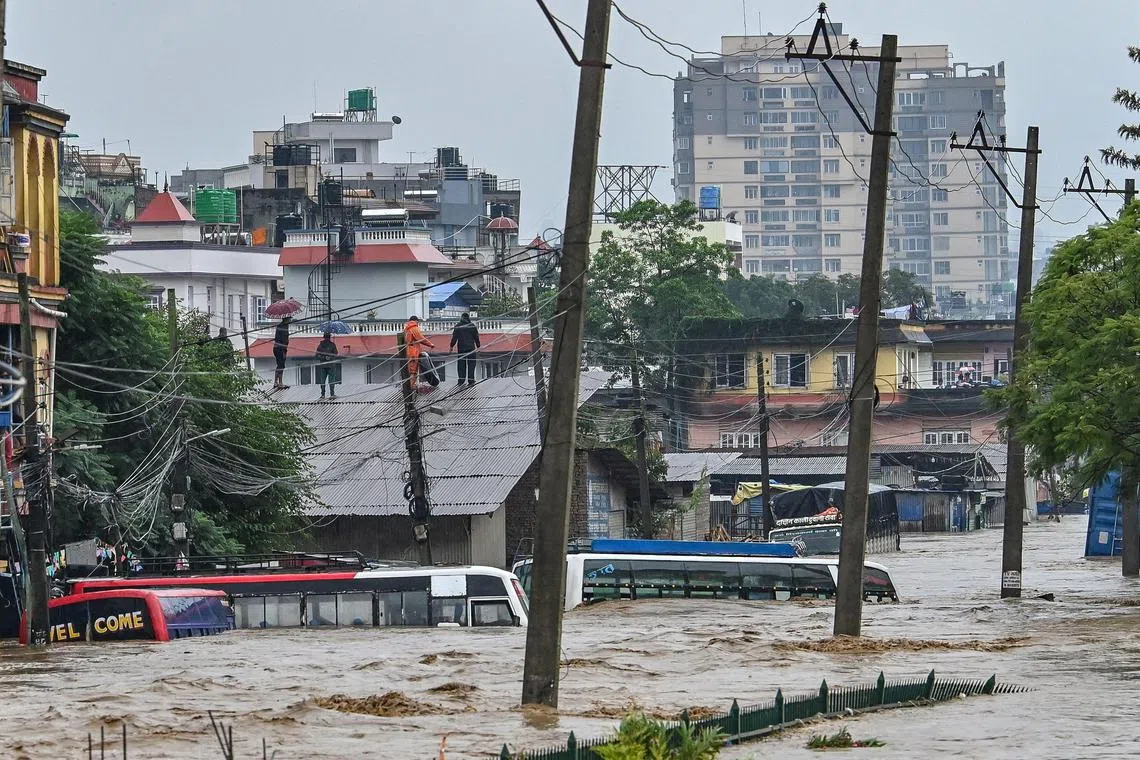Floods, landslides kill 148 in Nepal, including 6 players from national football academy
Sign up now: Get insights on Asia's fast-moving developments

Residents climbing over a rooftop as the neighbourhood was submerged in flood waters after the Bagmati River overflowed following heavy monsoon rains in Kathmandu, Nepal, on Sept 28.
PHOTO: AFP
Follow topic:
KATHMANDU – Residents of Nepal’s flood-hit capital returned to their mud-caked homes on Sept 29 to survey the wreckage of devastating floods that have killed at least 148 people across the Himalayan republic.
Deadly rain-related floods and landslides are common across South Asia during the monsoon season from June to September, but experts say climate change is increasing their frequency and severity.
Entire neighbourhoods in Kathmandu were inundated over the weekend, with flash floods reported in rivers coursing through the capital, and highways connecting the city with the rest of Nepal damaged extensively.
Mr Kumar Tamang, who lives in a slum area by a riverbank, told AFP that he and his family had to flee on Sept 28 as water rushed into his shack.
“This morning, we returned and everything looks different,” the 40-year-old said.
“We couldn’t even open the doors to our house, it was jammed with mud,” he added. “Yesterday we were afraid that the water would kill us, but today we have no water to clean with.”
Nepal’s National Disaster Risk Reduction and Management Authority said 148 people had been killed across the country, with another 59 still missing.
Home Ministry spokesman Rishi Ram Tiwari told AFP news agency that bulldozers were being used to clear several highways that had been blocked by debris, cutting Kathmandu off from the rest of the country.
“More than 3,000 people have been rescued,” he added.
At least 36 of those killed were aboard three vehicles and were buried alive when earth from a landslide careened onto a highway south of Kathmandu, Nepal Police spokesman Dan Bahadur Karki said.
Most of the deaths took place in the Kathmandu valley, which is home to four million people and the country’s capital, where the flooding brought traffic and normal activity to a standstill.
Among the dead were six players from the Nepali football association’s (Anfa) academy in Makwanpur district, who died after they were caught up in a landslide, Anfa said on Sept 28.
The incident occurred in Indrasarowar, not far from the capital Kathmandu, while the players were moving to a safer location, Anfa said in a statement.
Search efforts were launched after the six went missing, while other players were moved to a secure area. Rescue personnel later found the bodies of all six missing players.
“We express our heartfelt condolences to the bereaved families,” Anfa added.
The valley in which the capital sits recorded 240mm of rain in the 24 hours to the morning of Sept 28, the country’s weather bureau told The Kathmandu Post newspaper.
It was the highest rainfall recorded in Kathmandu since at least 1970, the report said.
The Bagmati River and its numerous tributaries, which cut through Kathmandu, broke their banks, inundating nearby homes and vehicles after midnight on Sept 28.
Residents struggled through chest-deep water to get to higher ground.
Ms Bishnu Maya Shrestha, who lived in another inundated area of Kathmandu, said she had to cut the roof of her home to escape.
“We jumped from one roof to another to safety, and finally they came with boats to rescue us,” Ms Shrestha told AFP.
More than 3,000 security personnel were deployed to assist rescue efforts with helicopters and motorboats.
Rescue teams were using rafts to pull survivors to safety.
Domestic flights resumed in and out of Kathmandu by the morning of Sept 29, after weather forced a complete stoppage from the evening of Sept 27, with more than 150 departures cancelled.
The summer monsoon brings to South Asia 70 per cent to 80 per cent of its annual rainfall.
Monsoon rains from June to September bring widespread death and destruction every year across the region, but the number of fatal floods and landslides has increased in recent years.
Experts say climate change has worsened their frequency and intensity.
A landslide that hit a road in Chitwan district in July pushed two buses with 59 passengers aboard into a river.
Three people were able to escape alive, but the authorities managed to recover only 20 bodies from the accident, with raging flood waters impeding the search.
More than 260 people have died in Nepal in rain-related disasters so far in 2024. AFP, REUTERS

